Budgets
You can define the rules of the budget using Budget types.
Create a budget using a specific starting Period range. You can later add more periods.
Select the Budget structure.
Create a Budget forecast.
How to view Budgets
Viewing Budgets
Select Budget / Budgets from the Main section of the pulse menu -
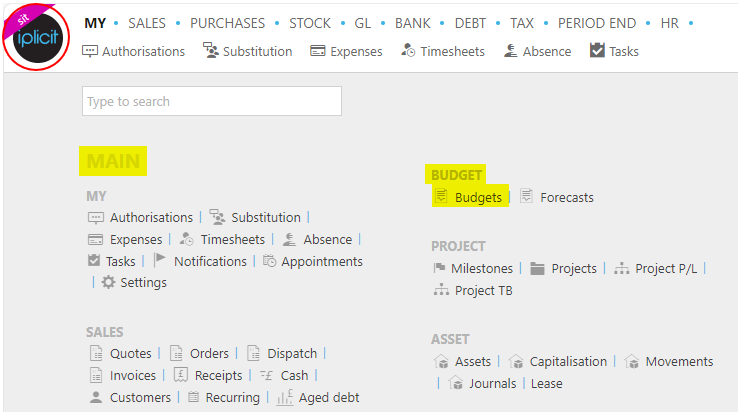
Note
This is an example screen shot of the pulse menu.
Position of the menu items within pulse will vary according to available options and dependant on personal screen resolution.
or from the Main Menu select Budget then Budgets -

or enter Budgets in the Quick Launch Side Menu.

This will then show the Budgets on the system where normal customisation of Sets can be used.

Tip
To modify the columns displayed, select  on the top right of the page, then tick/untick the information you want to hide or display.
on the top right of the page, then tick/untick the information you want to hide or display.
Consolidation period
Creating a consolidated budget can be done by ticking the Consolidated option when creating a new budget.
On consolidated budgets, a new Consolidation tab is available to select what budgets are going to be consolidated.
When adding new budgets to a consolidation, any new periods that are not part of the consolidation yet will be automatically created.
The consolidation period range can be restricted by deleting unwanted periods.
Note
Periods are consolidated together based on their ref. This can be used to consolidate budgets that are part of different financial year groups.
For example, a
202001period of an April starting financial year can be consolidated with a202004period of a January starting financial year by sharing the same value in the Ref column.
Consolidation forecasts
A consolidated budgets have no attribute or account structure of their own. They will inherit all the accounts and attribute rules of the sub budgets.
A consolidation forecast must be also created to consolidate budget data
The forecast editor will also present a Consolidation tab to select what forecasts of the previously selected budgets are to be used.
Once forecasts have been selected, the Budget forecast will present the consolidated view.
The consolidated forecast values cannot be edited.
Refreshing consolidated data
- A consolidated forecast is manually refreshed by pressing the Refresh button.
Budget authorisation
A budget has 3 types of budget forecasts:
Budgets
- In this section
- Create a new Budget
- Structure
- Periods
Base forecast
The first authorised forecast becomes the base forecast.
This can no longer be changed.
Last approved forecast
This is the latest approved forecast.
An approved forecast can still be amended and resubmitted for authorisation, unless it is the base forecast, which is locked.
Current forecast
Any forecast can be set as the current forecast on a budget.
In the case of multiple authorised forecasts, the current forecast can be a good starting point when looking at a budget.
Create a new Budget
Creating Budgets
Select Budgets from one of the options as shown above in Viewing Budgets.
Press New.

Select the Budget types.
Fill out the remaining fields.
Budget description: Freeform required text.
Legal Entity: Select the legal entity that the budget is being created for.
Currency: Select the currency
Consolidation: Tick this to create a consolidated budget.
If Data access control budget context enabled has been ticked and Custom data access control budget attribute has been set in Environment defaults ...
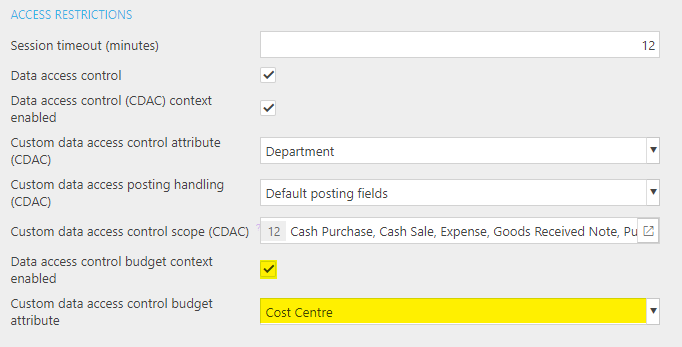
... then a field for the CDAC attribute value will be shown in the header section and will be a mandatory entry.

The budget structure specifies what data will be part of the budget: Accounts, Account groups and Posting attributes.
Accounts: This specifies what accounts are going to be part of the budget.

Tick the accounts to be included in the budget.
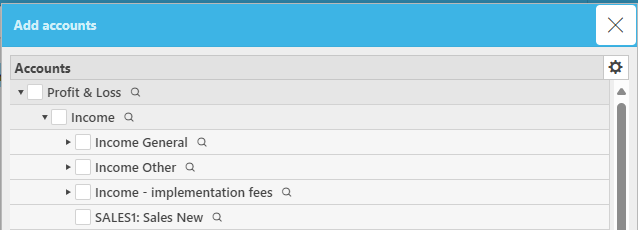
Using the Accounts button you can select:
- a complete section of your P&L or Balance Sheet
- individual account groups (and all its children)
- individual accounts
Note
You can use CTRL + Click to select a single account group without selecting its children.
You can edit the account selection at any point by clicking the Accounts button again, or by using the context menu to individually delete or add sub accounts:
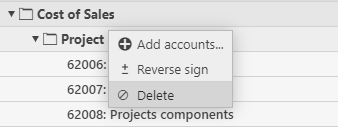
Account groups
An account group will include all the accounts associated with it.
You can choose to exclude a few accounts using the Exclude context menu.
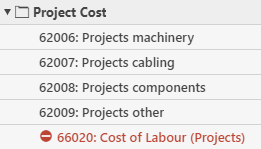
As new accounts are added to a certain group, these will be shown in purple. These accounts will be included in the budget on next refresh.
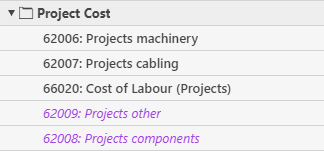
Budget and actual signs
When defining the chart of account structure of a budget you can also choose what is the preferred sign of budget values.
By default, budget values and actuals are in the General Ledger sign:

You can reverse the sign of the actuals presented in forecasts for an entire account group, or individual accounts from the budget structure:
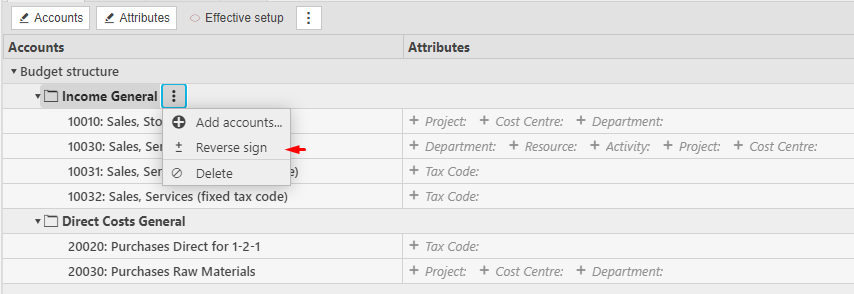
The budget structure will display an icon next to all the accounts that are going to be reversed:

Now the budget forecast actuals will be shown as positive, and the entered budget values can be adjusted as well:

Attributes: Select the attributes to be used in the budget. This is done by selecting one, then pressing the single chevron to move it over to the selected side.

Updated January 2025


